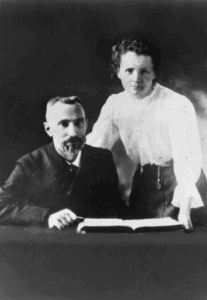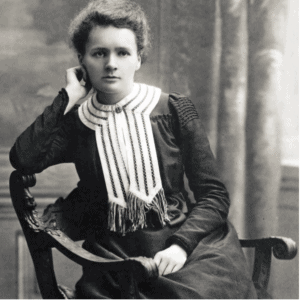Year of Marie Curie Skłodowska in Poland and France
In January 2011, Poland’s Senate unanimously adopted a res-olu on which, on the 100th anniversary of awarding Maria Curie-Skłodowska the Nobel Prize in Chemistry, designates 2011 as the Year of Maria Curie-Skłodowska to acknowledge her great contribu on to the global development of science.
Curie-Skłodowska (1867-1934) is the only woman honored with the Nobel Prize in two di erent scien c elds. In 1903, together with her husband Pierre Curie, she received the Nobel Prize in physics for research on radioac vity. In 1911, she was awarded the Nobel Prize, along with her husband, in Chemistry for discovering two new elements: polonium and radium.
In 1911, Curie-Skłodowska was awarded her second Nobel Prize; in 2011, the United Na ons declared that this year would be the Interna onal Year of Chemistry, in large part because this is the 100th anniversary of Curie-Skłodowska’s Nobel Prize in Chemistry.
The opening ceremony to celebrate the 100th anniversary of the Nobel Prize in Chemistry awarded to Curie-Skłodowska was held at the Sorbonne on January 29, 2011.
“Marie Curie is, of all celebrated beings,
the only one whom fame has not corrupted.”
~Albert Einstein
A Remarkable Woman
by Beata Paszyc and Melissa Szwanke

Born in Warsaw, in the Russian par on of Poland, on No-vember 7, 1867 to a school principal mother and teacher fa-ther, Maria Skłodowska was one of 5 children. She was an excellent student who loved physics, chemistry, math, biol-ogy and music. She spoke Polish, Russian, French and Eng-lish. Maria le Poland for France at the age 24 and studied at Sorbonne. Living on pennies a day, she devoted her life to her science work.
She fell in love with Pierre Curie through a shared loved of their work. Married July 26, 1895, they had two daughters, Irene and Eve. In France, she changed her name to Marie Curie, however Poles o en refer to her as Curie-Skłodowska. Maria was very patrio c, travelling to Poland frequently to keep the Polish language and heritage alive.
Maria obtained Masters degrees in physics and mathema cs and, later, her Doctorate in physics. Her determina on led to the discovery of Polonium and Radium. Perhaps the most famous of all women scien sts, Maria Curie-Skłodowska is notable for her many rsts, including: she was the rst to use the term radioac vity for this phenomenon; she was the rst woman in Europe to receive her doctorate of science; in 1903, she became the rst woman to win a Nobel Prize for Physics; she was also the rst female lecturer, professor and head of Laboratory at the Sorbonne University in Paris (1906). In 1911, she won an unprecedented second Nobel Prize (this me in chemistry) for her discovery and isolation of pure radium and radium components; she was the first person ever to receive two Nobel Prizes and win the award in two different fields and only person to win the award in different sciences; she was the first mother-Nobel Prize Laureate of daughter-Nobel Prize Laureate. Her oldest daughter Irene Joliot-Curie also won a Nobel Prize for Chemistry (1935).
Under Curie-Skłodowska’s direc on the Radium In-s tute in Paris became a world center for the study of radioac vity (1919). Thanks to the ini a ve of Maria, the Radium Ins -tute was opened in Warsaw (1932).
Maria Curie-Skłodowska died on July 4, 1934 of a disease caused by prolonged exposure to radia on. She was buried twice: on July 6, 1934, in the same cemetery in Sceaux with Pierre. Over 60 years later, the remains of Pierre and Maria Curie-Skłodowska were re-interred in France’s na onal mausoleum, the Panthéon, in Paris. She is the rst woman which has been laid to rest under the famous dome of the Pantheon in Paris (1995) for her own merits. Her tombstone reads” Marie Curie-Skłodowska. In her life me, Maria re-ceived 15 gold medals, 19 degrees, and many other honors.
Truly a remarkable woman.
Students Discover a Polish Heroine
by Melissa Szwanke

On April 1, 2011, students and faculty of Florida Interna onal University were cap -vated by the history that is Madame Maria Curie-Skłodowska.
Honorary Vice Consul of the Republic of Poland, Mrs. Beata Paszyc was invited to speak to students in a free event arranged by Le Cercle Français, Pi Delta Phi and the Department of Modern Languages. Invited by Professor Maria Antonieta Garcia, professor of French language, Mrs. Paszyc shared the story of an extraordinary Pol-ish woman.
Mrs. Paszyc prepared a special presenta on en tled Madame Maria Curie -Skłodowska: The Daughter of Poland, A Scien c Genius of the World. In a crowded conference room, with standing room only, over 25 students learned of the scien c work and monumental discoveries of Madame Curie-Sklodowska and her husband, Pierre Curie. Addi onally, each of the par cipants received a copy of Madame Curie: Daughter of Poland by Robert Woznicki, a book published by AIPC.
Students represented majors including chemistry, psychology, English, economics, French and interna onal rela ons; faculty members represented the Departments of Medicine, Radiology and German Language.
The audience posed very interes ng and insigh ul ques ons about her as a scien st, who never patented any of her discoveries and as a working mother of two, demon-stra ng their cap va on in the story and testifying to how much was learned that day.
“Nothing in life is to be feared, it is only to be understood.
Now is the time to understand more, so that we may fear less.”
~Maria Curie-Skłodowska

Suggested reading:
Madame Curie: A Biography,by Eve Curie (Doubleday, 1955)
Madame Curie Daughter of Poland,by Robert Woznicki (American Ins tute of Polish Culture, 1983)
Polish laureates of the Nobel Prize for Science
Maria Skłodowska-Curie, Physics (1903)
Marie Skłodowska-Curie, Chemistry (1911)
Tadeus Reichstein, Physiology or Medicine (1950)
Roald Hoffmann, Chemistry (1981)
Georges Charpak, Physics (1992)









